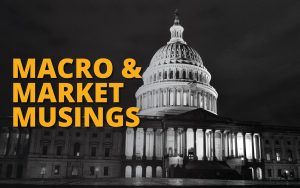Comments based on information available as of 6:55am CT on 9/26/2025
Growth: Silver Linings Emerge 
Amid signs of cooling in some areas (job growth and existing home sales), pockets of resilience are shining through. U.S. new home sales soared in August to an annualized 800,000 units – the highest since early 2022 – handily beating expectations. Second quarter gross domestic product was revised up to a 3.8% annualized pace. The latest manufacturing and services PMI (purchasing manager indexes) readings dipped slightly but stayed above 50, suggesting the economy is still growing (if a bit more slowly). Even if the labor market wasn’t as solid as originally thought, that doesn’t mean it’s not going to firm up.
Inflation: Still Tame
Companies are largely absorbing cost increases. With profit margins still at near record levels, they have the capacity to do so. Fed officials now openly express confidence that recent tariffs will have “only a small and short-lived effect on inflation.” We see this in practice: even industries hit directly by tariffs (like metals) are warning that raising prices too much would just destroy demand, a built-in brake on runaway inflation. Unlike during the inflation coming out of COVID lockdowns, companies can’t hide behind the excuse that “everyone else is doing it.”
Policy: Central Bank Cacophony
As is typical in the week following a Federal Reserve rate decision, Fed officials emerge from their “quiet period” with enthusiasm—and opinions. It’s always important to distinguish between who votes and who doesn’t. Among this year’s voters, Governor Miran stands out as the lone advocate for aggressive near-term rate cuts. Governor Bowman also supports cuts, though likely at a more measured pace. Governor Waller appears to favor a “slow and steady” approach to easing. The remaining nine voting members are striking a more cautious tone—either signaling that the latest cut may be the last, or advocating for a very gradual path forward. Cutting through the cacophony, the most probable outcome is a couple more rate cuts before year-end. But even that forecast should be held with modest conviction.
Looking Ahead: Shutdown Countdown
With the end of the federal government’s fiscal year around the corner, there’s not compromise in site. A government shutdown isn’t a literal shutting down of every governmental activity. Social Security checks will still go out, Medicare will still function, interest on the debt will still get paid. There are a lot of “essential services” that will continue. National parks and museums may close. The upcoming jobs report may be delayed. Regulatory approvals can be put on hold. Workers may get furloughed–or, apparently, even let go completely, which is a new twist–but they have always gotten backpay. The market and broader macroeconomic effects of a shutdown–even lengthy ones–are often mere blips on the charts.